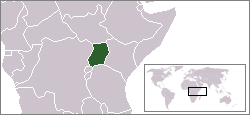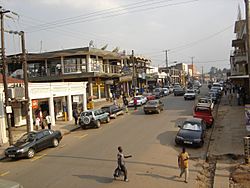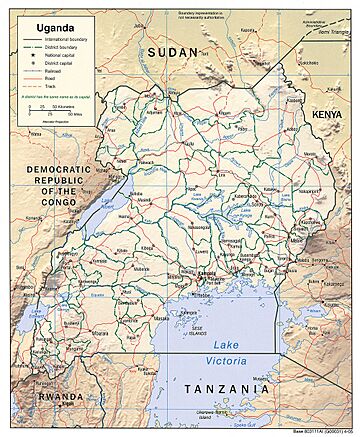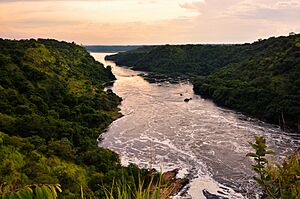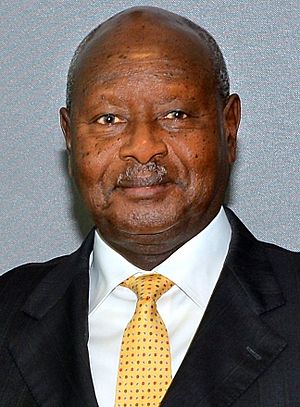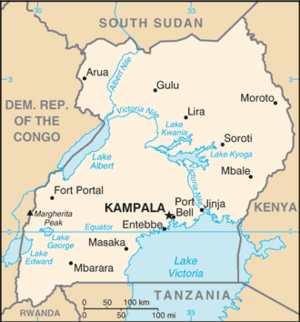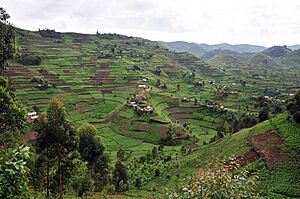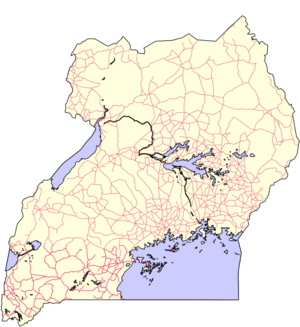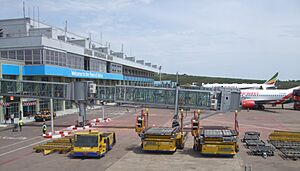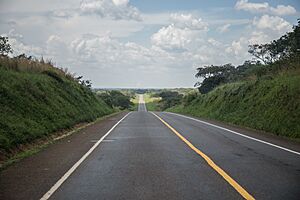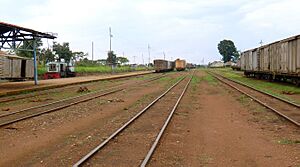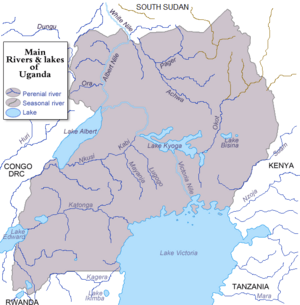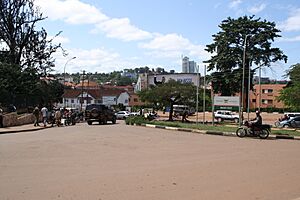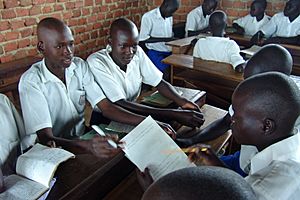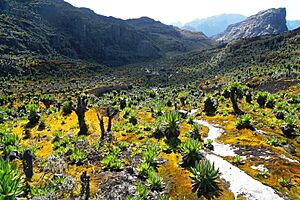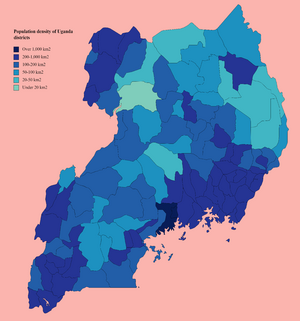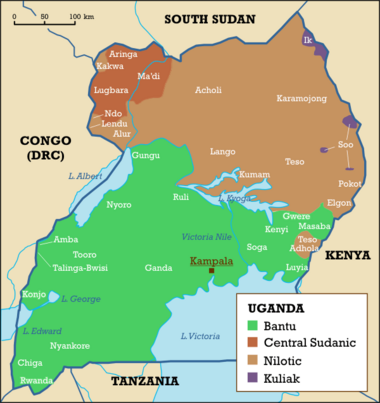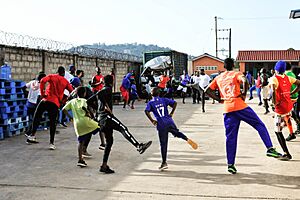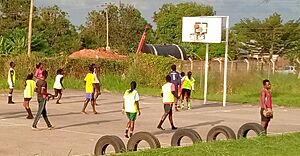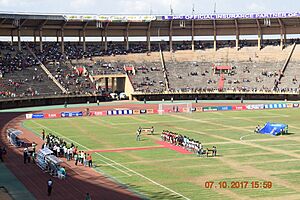Uganda facts for kids
Quick facts for kids
Republic of Uganda
Jamhuri ya Uganda (Swahili)
Official Name in Local Languages
|
|||||||
|---|---|---|---|---|---|---|---|
|
|
|||||||
|
Motto: "For God and My Country"
"Kwa Mungu na nchi yangu" |
|||||||
|
Anthem: "Oh Uganda, Land of Beauty"
|
|||||||
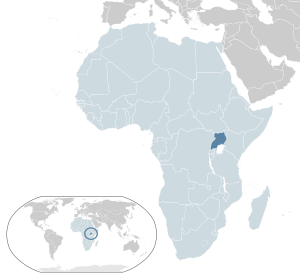 |
|||||||
| Capital and largest city
|
Kampala | ||||||
| Official languages |
|
||||||
| Ethnic groups
(2014)
|
|
||||||
| Religion
(2014 census)
|
|
||||||
| Demonym(s) | Ugandan | ||||||
| Government | Unitary presidential republic under a dominant-party authoritarian state | ||||||
| Yoweri Museveni | |||||||
| Jessica Alupo | |||||||
| Robinah Nabbanja | |||||||
| Legislature | Parliament | ||||||
| Independence
from the United Kingdom
|
|||||||
|
• Dominion
|
9 October 1962 | ||||||
|
• Admitted to the United Nations
|
25 October 1962 | ||||||
|
• Republic declared
|
9 October 1963 | ||||||
|
• Current constitution
|
8 October 1995 | ||||||
| Area | |||||||
|
• Total
|
241,038 km2 (93,065 sq mi) (79th) | ||||||
|
• Water (%)
|
15.39 | ||||||
| Population | |||||||
|
• 2024 estimate
|
49,283,041 (34th) | ||||||
|
• Density
|
157.1/km2 (406.9/sq mi) (75th) | ||||||
| GDP (PPP) | 2024 estimate | ||||||
|
• Total
|
|||||||
|
• Per capita
|
|||||||
| GDP (nominal) | 2023 estimate | ||||||
|
• Total
|
|||||||
|
• Per capita
|
|||||||
| Gini (2016) | ▲ 42.0 medium |
||||||
| HDI (2022) | medium · 159th |
||||||
| Currency | Ugandan shilling (UGX) | ||||||
| Time zone | UTC+3 (EAT) | ||||||
| Driving side | left | ||||||
| Calling code | +256a | ||||||
| ISO 3166 code | UG | ||||||
| Internet TLD | .ug | ||||||
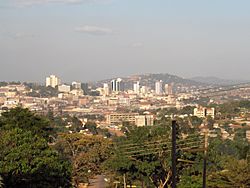
The Republic of Uganda is a landlocked country in east Africa. Its capital and biggest city is Kampala.
The currency is the Ugandan Shilling. The official languages of Uganda are English and Swahili. The most common religion is Christianity. The President of Uganda is Yoweri Kaguta Museveni. The country is to the East of Africa. The population of Uganda is 32 million people. The area of Uganda is about 236,040 km2.
Uganda produces coffee and copper.
The literacy rate of Uganda is 68%, which mean people in Uganda who are at least 15 years old know how to read and write.
Uganda is among countries thought to be very corrupt by Transparency International. It is rated at 2.4 on a scale from 0 (the most corrupt) to 10 (the most clean). Uganda is one of the poorest nations in the world. 37.7 percent of the people live on less than $1.25 a day.
Contents
History
The history of Uganda comprises the history of the people who inhabited the territory of present-day Uganda before the establishment of the Republic of Uganda, and the history of that country once it was established. Evidence from the Paleolithic era shows humans have inhabited Uganda for at least 50,000 years. The forests of Uganda were gradually cleared for agriculture by people who probably spoke Central Sudanic languages.
In 1894, Uganda became a protectorate of the British Empire, and in 1962 the United Kingdom granted independence to Uganda making Sir Edward Muteesa Walugembe the first President of Uganda and Kabaka of Buganda. Idi Amin deposed Milton Obote to became ruler of Uganda in 1971, a position he would occupy for eight years until he was ousted in 1979 as a result of the Uganda-Tanzania War. After a series of other leaders since Amin's fall, Yoweri Museveni came to power in 1986 and has led Uganda since that time.
Geography
Uganda is located in southeast Africa between 1º S and 4º N latitude, and between 30º E and 35º E longitude. Its geography is very diverse, consisting of volcanic hills, mountains, and lakes. The country sits at an average of 900 meters above sea level. Both the eastern and western borders of Uganda have mountains. The Ruwenzori mountain range contains the highest peak in Uganda, which is named Alexandra and measures 5,094 meters.
Lakes and rivers
Much of the south of the country is heavily influenced by one of the world's biggest lakes, Lake Victoria, which contains many islands. The most important cities are located in the south, near this lake, including the capital Kampala and the nearby city of Entebbe. Lake Kyoga is in the centre of the country and is surrounded by extensive marshy areas.
Although landlocked, Uganda contains many large lakes. Besides Lakes Victoria and Kyoga, there are Lake Albert, Lake Edward, and the smaller Lake George. It lies almost completely within the Nile basin. The Victoria Nile drains from Lake Victoria into Lake Kyoga and thence into Lake Albert on the Congolese border. It then runs northwards into South Sudan. An area in eastern Uganda is drained by the Suam River, part of the internal drainage basin of Lake Turkana. The extreme north-eastern part of Uganda drains into the Lotikipi Basin, which is primarily in Kenya.
Biodiversity and conservation
Uganda has 60 protected areas, including ten national parks: Bwindi Impenetrable National Park and Rwenzori Mountains National Park (both UNESCO World Heritage Sites), Kibale National Park, Kidepo Valley National Park, Lake Mburo National Park, Mgahinga Gorilla National Park, Mount Elgon National Park, Murchison Falls National Park, Queen Elizabeth National Park, and Semuliki National Park.
Uganda is home to a vast number of species, including a population of mountain gorillas in the Bwindi Impenetrable National Park, gorillas and golden monkeys in the Mgahinga Gorilla National Park, and hippos in the Murchison Falls National Park. Jackfruit can also be found throughout the country. The country had a 2019 Forest Landscape Integrity Index mean score of 4.36/10, ranking it 128th globally out of 172 countries.
Government and politics
The President of Uganda is both head of state and head of government. The president appoints a vice-president and a prime minister to aid him in governing.
The parliament is formed by the National Assembly, which has 449 members. These include 290 constituency representatives, 116 district woman representatives, 10 representatives of the Uganda People's Defense Forces, 5 representatives of the youth, 5 representatives of workers, 5 representatives of persons with disabilities, and 18 ex officio members.
Administrative divisions
As of 2022[update], Uganda is divided into four Regions of Uganda and 136 districts. Rural areas of districts are subdivided into sub-counties, parishes, and villages. Municipal and town councils are designated in urban areas of districts.
Political subdivisions in Uganda are officially served and united by the Uganda Local Governments Association (ULGA), a voluntary and non-profit body which also serves as a forum for support and guidance for Ugandan sub-national governments.
Parallel with the state administration, five traditional Bantu kingdoms have remained, enjoying some degrees of mainly cultural autonomy. The kingdoms are Toro, Busoga, Bunyoro, Buganda, and Rwenzururu. Furthermore, some groups attempt to restore Ankole as one of the officially recognised traditional kingdoms, to no avail yet. Several other kingdoms and chiefdoms are officially recognised by the government, including the union of Alur chiefdoms, the Iteso paramount chieftaincy, the paramount chieftaincy of Lango and the Padhola state.
Economy and infrastructure
The Bank of Uganda is the central bank of Uganda and handles monetary policy along with the printing of the Ugandan shilling.
In 2015, Uganda's economy generated export income from the following merchandise: coffee (US$402.63 million), oil re-exports (US$131.25 million), base metals and products (US$120.00 million), fish (US$117.56 million), maize (US$90.97 million), cement (US$80.13 million), tobacco (US$73.13 million), tea (US$69.94 million), sugar (US$66.43 million), hides and skins (US$62.71 million), cocoa beans (US$55.67 million), beans (US$53.88 million), simsim (US$52.20 million), flowers (US$51.44 million), and other products (US$766.77 million).
The country has been experiencing consistent economic growth. In fiscal year 2015–16, Uganda recorded gross domestic product growth of 4.6 percent in real terms and 11.6 percent in nominal terms. This compares to 5.0 percent real growth in fiscal year 2014–15.
The country has largely untapped reserves of both crude oil and natural gas. While agriculture accounted for 56 percent of the economy in 1986, with coffee as its main export, it has now been surpassed by the services sector, which accounted for 52 percent of GDP in 2007. In the 1950s, the British colonial regime encouraged some 500,000 subsistence farmers to join co-operatives. Since 1986, the government (with the support of foreign countries and international agencies) has acted to rehabilitate an economy devastated during the regime of Idi Amin and the subsequent civil war.
In 2012, the World Bank still listed Uganda on the Heavily Indebted Poor Countries list.
Economic growth has not always led to poverty reduction. Despite an average annual growth of 2.5 percent between 2000 and 2003, poverty levels increased by 3.8 percent during that time. This has highlighted the importance of avoiding jobless growth and is part of the rising awareness in development circles of the need for equitable growth not just in Uganda, but across the developing world.
With the Uganda securities exchanges established in 1996, several equities have been listed. The government has used the stock market as an avenue for privatisation. All government treasury issues are listed on the securities exchange. The Capital Markets Authority has licensed 18 brokers, asset managers, and investment advisors including: African Alliance Investment Bank, Baroda Capital Markets Uganda Limited, Crane Financial Services Uganda Limited, Crested Stocks and Securities Limited, Dyer & Blair Investment Bank, Equity Stock Brokers Uganda Limited, Renaissance Capital Investment Bank and UAP Financial Services Limited. As one of the ways of increasing formal domestic savings, pension sector reform is the centre of attention (2007).
Uganda traditionally depends on Kenya for access to the Indian Ocean port of Mombasa. Efforts have intensified to establish a second access route to the sea via the lakeside ports of Bukasa in Uganda and Musoma in Tanzania, connected by railway to Arusha in the Tanzanian interior and to the port of Tanga on the Indian Ocean. Uganda is a member of the East African Community and a potential member of the planned East African Federation.
Uganda has a large diaspora, residing mainly in the United States and the United Kingdom. This diaspora has contributed enormously to Uganda's economic growth through remittances and other investments (especially property). According to the World Bank, Uganda received in 2016 an estimated US$1.099 billion in remittances from abroad, second only to Kenya (US$1.574 billion) in the East African Community, and seventh in Africa. Uganda also serves as an economic hub for a number of neighbouring countries like the Democratic Republic of the Congo, South Sudan, and Rwanda.
The Ugandan Bureau of Statistics announced inflation was 4.6 percent in November 2016. On 29 June 2018, Uganda's statistics agency said the country registered a drop in inflation to 3.4 percent in the financial year ending 2017/18 compared to the 5.7 percent recorded in the financial year 2016/17.
Industry
Uganda ranked as number 102 among the countries of the world in nominal Gross Domestic Product by the International Monetary Fund with a GDP of 26,349 (US$million). The World Bank ranked Uganda as number 99 in nominal GDP with a GDP of 25,891 (US$million). Based on the GDP with purchasing power parity the IMF ranked Uganda as number 86 (91,212 million of current Int$) and the World Bank ranked them 90 (79,889 million of current Int$).
Since the 1990s, the economy in Uganda is growing. Real gross domestic product (GDP) grew at an average of 6.7% annually during the period 1990–2015, whereas real GDP per capita grew at 3.3% per annum during the same period.
Air transportation
There are 36 airports in Uganda. Commercial airlines operate scheduled passenger services out of four airports. Uganda currently has one functioning international airport, Entebbe International Airport, which is located 25 miles (40 km) south-west of Kampala. In 2017, the airport traffic was 1.53 million passengers, 8% more than the previous year. A second international airport, Hoima International Airport, is currently under construction.
Road network
Road transportation is the most important way of transportation in Uganda. 95% of freight and passenger traffic is handled by road traffic. The road network in Uganda is approximately 129,469 km (80,448 mi) long. About 4% of these roads are paved which equates to only about 5,300 kilometres (3,300 mi) of paved road. The different types of roads are national roads (22,009 km (13,676 mi)—17%), district roads (33,661 km (20,916 mi)—26%), urban roads (9,062 km (5,631 mi)—7%), and community roads (64,734 km (40,224 mi)—50%). The national roads make up about 17% of the road network but carry over 80% of the total road traffic. In Uganda there are 83,000 private cars which means 2.94 cars per 1000 inhabitants.
Railroad
The rail network in Uganda is approximately 1,260 kilometres (780 mi) long. The longest lines are the main line from Kampala to Tororo (249 kilometres (155 mi)), the western line from Kampala to Kasese (333 kilometres (207 mi)), the northern line from Tororo to Pakwach (641 kilometres (398 mi)).
Communications
There are several systems of communication, including telephony, radio and television broadcasts, internet, mail, and newspapers. The use of phones and the internet has rapidly increased.
There are seven telecommunications companies and, as of 2018[update], over 24 million subscribers according to the Uganda Communications Commission, in a population of 48 million. More than 95% of internet connections are made using mobile phones.
Energy
Uganda is richly endowed with abundant energy resources, which are fairly distributed throughout the country. These include hydropower, biomass, solar, geothermal, peat and fossil fuels.
In the 1980s, the majority of energy in Uganda came from charcoal and wood. However, oil was found in the Lake Albert area, totaling an estimated 95 million cubic metres (3.4×109 cu ft) of crude. Heritage Oil discovered one of the largest crude oil finds in Uganda, and continues operations there.
Uganda and Tanzania signed a deal on 13 September 2016 that will see the two countries build a 1,445 km, $3.5bn crude oil pipeline. The Uganda–Tanzania Crude Oil Pipeline (UTCOP), also known as the East African Crude Oil Pipeline (EACOP) will be the first of its kind in East Africa, will connect Uganda's oil-rich Hoima region with the Indian Ocean through the Tanga port in Tanzania.
Uganda's favorable enabling environment and broad presence of private sector investment presents a unique opportunity to deliver on Power Africa goals. Uganda is one of the few sub-Saharan African countries to have liberalized and financially viable energy markets, with generation, transmission and supply segments unbundled since 2001. There is an independent Electricity Regulatory Authority that undertakes sector regulation and oversight. The largest distribution company, UMEME is privately owned and has a 20-year concession for distribution and retail. The country, however, is divided into 13 rural service territories, and 6 of these are being managed by small distribution companies. Independent power producers (IPPs) currently account for nearly 60% of generation capacity. Issues with integrated planning and the financial ecosystem persist.
Water supply and sanitation
According to a 2006 published report, the Ugandan water supply and sanitation sector had made substantial progress in urban areas since the mid-1990s, with substantial increases in coverage as well as in operational and commercial performance. Sector reforms in the period 1998–2003 included the commercialisation and modernisation of the National Water and Sewerage Corporation operating in cities and larger towns, as well as decentralisation and private sector participation in small towns.
Although these reforms have attracted significant international attention, 38 percent of the population still had no access to an improved water source in 2010. Concerning access to improved sanitation, figures have varied widely. According to government figures, it was 70 percent in rural areas and 81 percent in urban areas in 2011, while according to UN figures it was only 34 percent.
The water and sanitation sector was recognised as a key area under the 2004 Poverty Eradication Action Plan (PEAP), Uganda's main strategy paper to fight poverty. According to a 2006 published report, a comprehensive expenditure framework had been introduced to co-ordinate financial support by external donors, the national government, and nongovernmental organisations. The PEAP estimated that from 2001 to 2015, about US$1.4 billion, or US$92 million per year, was needed to increase water supply coverage up to 95 percent, with rural areas needing US$956 million, urban areas and large towns needing US$281 million, and small towns needing US$136 million.
Education
Uganda's educational system, while lacking in many areas, has seen significant change since the late 1990s. The educational system is set up so that children spend seven years in primary school, six years in secondary school, and three to five years in post secondary school. In 1997, the government declared that primary school would be free for all children. This amendment has had huge benefits. In 1986, only two million children were attending primary school. By 1999, six million children were attending primary school, and this number has continued to climb.
Following significant gains in access to primary education since 1997 when universal primary education (UPE) was introduced, Uganda in 2007 became the first country in sub-Saharan Africa to introduce universal secondary education (USE). This bold step by the Government of Uganda led to an increase in lower secondary enrolment of nearly 25% between 2007 and 2012.
At the 2002 census, Uganda had a literacy rate of 66.8 percent (76.8 percent male and 57.7 percent female). Public spending on education was at 5.2 percent of the 2002–2005 GDP.
As of 2020[update], the NCHE website listed 46 private accredited universities, including Makerere University, Mbarara University of science and technology, Kyambogo University, Gulu University, Uganda Christian University, Kampala international University.
Tourism
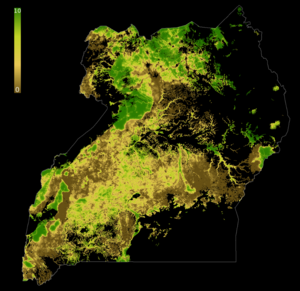
Tourism in Uganda is focused on Uganda's landscape and wildlife. It is a major driver of employment, investment and foreign exchange, contributing 4.9 trillion Ugandan shillings (US$1.88 billion or €1.4 billion as of August 2013) to Uganda's GDP in the financial year 2012–13. The Uganda Tourism Board is responsible for maintaining information pertaining to tourism in Uganda. The main attractions are photo safaris through the National parks and game Reserves. Other attractions include the Mountain Gorillas found in Bwindi Impenetrable National Park (BINP) and Mgahinga Gorilla National Park (MGNP), Uganda having some of the oldest cultural kingdom in Africa has many Cultural sites. Uganda is a birding paradise boasting a massive bird list of more than 1073 recorded bird species ranking 4th in Africa's bird species and 16th internationally. Uganda has landscapes ranging from white-capped Rwenzori mountains to the Great Rift Valley.
Science and technology
The National Science, Technology and Innovation Policy dates from 2009. Its overarching goal is to 'strengthen national capability to generate, transfer and apply scientific knowledge, skills and technologies that ensure sustainable utilization of natural resources for the realisation of Uganda's development objectives.' The policy precedes Uganda Vision 2040, which was launched in April 2013 to transform 'Ugandan society from a peasant to a modern and prosperous country within 30 years,' in the words of the Cabinet. Uganda Vision 2040 vows to strengthen the private sector, improve education and training, modernize infrastructure and the underdeveloped services and agriculture sectors, foster industrialization and promote good governance, among other goals. Potential areas for economic development include oil and gas, tourism, minerals and information and communication technologies (ICTs).
Uganda was ranked 121st in the Global Innovation Index in 2024, down from 102nd in 2019. Research funding climbed between 2008 and 2010 from 0.33% to 0.48% of GDP. Over the same period, the number of researchers doubled (in head counts) from 1 387 to 2 823, according to the UNESCO Institute for Statistics. This represents a leap from 44 to 83 researchers per million inhabitants over the same period. One in four researchers is a woman. Uganda has been able to manufacture prototype of cars called kiira in which the government invested US$70.
Demographics
Uganda's population grew from 9.5 million people in 1969 to 34.9 million in 2014. With respect to the last inter-censal period (September 2002), the population increased by 10.6 million people in the past 12 years. Uganda's median age of 15 years is the lowest in the world. Uganda has the fifth highest total fertility rate in the world, at 5.97 children born per woman (2014 estimates).
There were about 80,000 Indians in Uganda before Idi Amin required the expulsion of Ugandan-Asians (mostly of Indian origin) in 1972, which reduced the population to as low as 7,000. Many Indians, however, returned to Uganda after Amin's ouster in 1979. Around 90 percent of Ugandan Indians reside in Kampala. There is also a population of about 10,000 white Africans and 3,000 Arabs in the country.
According to the UNHCR, Uganda hosts over 1.4 million refugees on its soil as of August 2021. Most come from neighbouring countries in the African Great Lakes region, particularly South Sudan (68.0 percent) and Democratic Republic of the Congo (24.6%). In August 2021, Uganda received some refugees from Afghanistan following the Taliban takeover.
Languages
Swahili, a widely used language throughout the African Great Lakes region, was approved as the country's second official national language in 2005. English was the only official language until the constitution was amended in 2005. Although Swahili has not been favoured by the Bantu-speaking populations of the south and south-west of the country, it is an important lingua franca in the northern regions. It is also widely used in the police and military forces, which may be a historical result of the disproportionate recruitment of northerners into the security forces during the colonial period. The status of Swahili has thus alternated with the political group in power. For example, Idi Amin, who came from the north-west, declared Swahili to be the national language.
Religion
The Roman Catholic Church had the largest number of adherents (39.3 percent, down from 41.6 in 2002), followed by the Anglican Church of Uganda (32 percent, down from 35.9 percent). The category of Evangelical/Pentecostal/Born-Again showed the most growth, rising from 4.7% in 2002 to 11.1% in 2018. Adventist and other Protestant churches claimed most of the remaining Christians, although there was also a small Eastern Orthodox community. The next most reported religion of Uganda was Islam, with Muslims representing 14% percent of the population, up from 12.1% in 2002.
The remainder of the population according to the 2014 census followed traditional religions (0.1 percent, down from 1% in 2002), other religions (1.4 percent), or had no religious affiliation (0.2 percent).
Largest cities and towns
|
Largest urban centres in Uganda
Uganda Bureau of Statistics 2016, National Population and Housing Census 2014 – Main Report, p. 11 |
||
|---|---|---|
| Rank | Pop. | |
| 1 | Kampala | 1,507,114 |
| 2 | Nansana | 365,857 |
| 3 | Kira | 317,428 |
| 4 | Makindye Ssabagabo | 282,664 |
| 5 | Mbarara | 195,160 |
| 6 | Mukono | 162,744 |
| 7 | Gulu | 149,802 |
| 8 | Lugazi | 114,163 |
| 9 | Kasese | 103,293 |
| 10 | Masaka | 101,557 |
Culture
Owing to the large number of communities, culture within Uganda is diverse. Many Asians (mostly from India) who were expelled during the regime of Idi Amin have returned to Uganda.
Media
Uganda has a number of media outlets that broadcast domestically and globally. They cover news, magazines, sports, business and entertainment.
Popular Ugandan newspapers include:
- New Vision
- Daily Monitor
- Bukedde
- The Observer
- East African Business Week
- Red Pepper
The most popular television stations in Uganda include:
- Uganda Broadcasting Corporation (UBC)
- NTV
- NBS Television
- Sanyuka TV
- Baba TV
- Top TV
- Spark TV
All of the media is controlled and regulated under the Uganda Communications Commission (UCC).
Sports
Football is the national sport in Uganda. The Uganda national football team, nicknamed "The Cranes" is controlled by the Federation of Uganda Football Associations. They have never qualified for the FIFA World Cup finals. Their best finish in the African Cup of Nations was second in 1978. Among clubs, SC Villa are the most successful, having won the national league 16 times and reached the final of the African Cup of Champions Clubs in 1991, a feat also achieved by Simba SC in 1972. KCCA are second in national league wins with 13.
As of 2020[update], Uganda at the Olympics has won a total of two gold, three silver, and two bronze medals; four of which were in boxing and three in athletics. Uganda at the Commonwealth Games has collected 13 gold medals and a total 49 medals, all in boxing and athletics.
The Uganda national boxing team is called The Bombers. They have won four medals at the Summer Olympics from 1968 to 1980, as well as two medals the 1974 World Amateur Boxing Championships. Notable boxers include Cornelius Boza-Edwards, Justin Juuko, Ayub Kalule, John Mugabi, Eridadi Mukwanga, Joseph Nsubuga, Kassim Ouma, Sam Rukundo and Leo Rwabwogo.
In athletics, John Akii-Bua won the first Olympic gold medal for Uganda. At the 1972 Summer Olympics in Munich, he won the 400m hurdles race with a world record time of 47.82 seconds. 400 metres runner Davis Kamoga earned the bronze medal at 1996 Summer Olympics in Atlanta and the silver medal at the 1997 World Championships. Dorcus Inzikuru won the 3000 m steeplechase at the 2005 World Championships and the 2006 Commonwealth Games.
Stephen Kiprotich has won the marathon at the 2012 Summer Olympics in London and the 2013 World Championships, and finished second at the 2015 Tokyo Marathon. Joshua Cheptegei has won 10 km races at the World Championships, World Athletics Cross Country Championships and Commonwealth Games, and has set world records in 5 km and 15 km. Halimah Nakaayi won the 800 meters race at the 2019 World Championships.
In cricket, Uganda was part of the East Africa team that qualified for the Cricket World Cup in 1975. Recently Uganda national cricket team qualified for 2024 ICC T20 World Cup.
The country has an increasingly successful national basketball team. It is nicknamed "The Silverbacks," and made its debut at the 2015 FIBA Africa Championship.
In July 2011, Kampala, Uganda qualified for the 2011 Little League World Series in Williamsport, Pennsylvania for the first time, beating Saudi Arabian baseball team Dharan LL, although visa complications prevented them from attending the series. Little League teams from Uganda qualified for and attended the 2012 Little League World Series.
Cinema
The Ugandan film industry is relatively young. It is developing quickly, but still faces an assortment of challenges. There has been support for the industry as seen in the proliferation of film festivals such as Amakula, Pearl International Film Festival, Maisha African Film Festival and Manya Human Rights Festival. However, filmmakers struggle against the competing markets from other countries on the continent such as those in Nigeria and South Africa in addition to the big budget films from Hollywood.
The first publicly recognised film that was produced solely by Ugandans was Feelings Struggle, which was directed and written by Hajji Ashraf Ssemwogerere in 2005. This marks the year of ascent of film in Uganda, a time where many enthusiasts were proud to classify themselves as cinematographers in varied capacities.
The local film industry is polarised between two types of filmmakers. The first are filmmakers who use the Nollywood video film era's guerrilla approach to film making, churning out a picture in around two weeks and screening it in makeshift video halls. The second is the filmmaker who has the film aesthetic, but with limited funds has to depend on the competitive scramble for donor cash.
Though cinema in Uganda is evolving, it still faces major challenges. Along with technical problems such as refining acting and editing skills, there are issues regarding funding and lack of government support and investment. There are no schools in the country dedicated to film, banks do not extend credit to film ventures, and distribution and marketing of movies remains poor.
The Uganda Communications Commission (UCC) is preparing regulations starting in 2014 that require Ugandan television to broadcast 70 percent Ugandan content and of this, 40 percent to be independent productions. With the emphasis on Ugandan film and the UCC regulations favouring Ugandan productions for mainstream television, Ugandan film may become more prominent and successful in the near future.
Related pages
Images for kids
-
The Crested crane is the national bird.
-
U.S. President George W. Bush met with President Yoweri Museveni in Entebbe, Uganda, July 11, 2003.
-
Downtown Kampala, the capital city.
-
Northern corridor road from Kampala to Gulu at Matugga Town in Wakiso District
See also
 In Spanish: Uganda para niños
In Spanish: Uganda para niños




